How To Make Money Trees In Animal Crossing
This article requires clean-up to meet the quality standards of the Animal Crossing Wiki .
The money tree (also referred to as a Bell tree) is a type of tree featured in the Animal Crossing series. To grow them, the player must bury a bag of Bells using a golden shovel. After the tree has fully grown, it will bloom with three bags of Bells at amounts dependent on how much was initially buried. The tree will only produce money once before becoming a regular hardwood tree.
In Animal Forest, Animal Crossing, Animal Forest e+, and New Horizons, money trees can only be planted by burying money in the daily Shining Spot in the player's town.
Contents
- 1 In New Horizons
- 1.1 Profiting
- 2 Money Tree Probability (Pre-New Horizons)
- 3 Dealing with Deforestation
- 4 Gallery
- 5 Trivia
- 6 References
In New Horizons
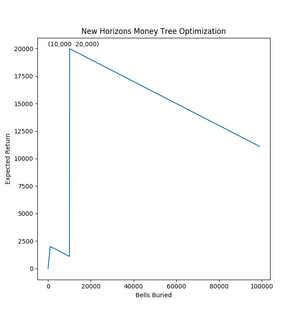
The expected return on investment for any amount of bells buried. If the player buries 10,000 bells, they are guaranteed to get 30,000. This gives a return of 20,000.
In New Horizons, one shining spot appears per day, granting the player both 1,000 Bells and one opportunity to plant a Bell tree.
- If the player plants 100-1000 bells, they will always get a tree with 3x 1000 bells.
- If the player plants 2,000-9,000 bells, there is a 70% chance of 3x 1000 bells and a 30% chance of 3x the amount buried.
- If the player buries 10,000-99,000 bells, there is a 70% chance of 3x 10,000 bells and a 30% chance of 3x the amount buried.
- The game decides this the moment the money is buried in the glowing spot. There is no pattern whatsoever to when you will get the original investment back or the 'capped' investment.
Profiting
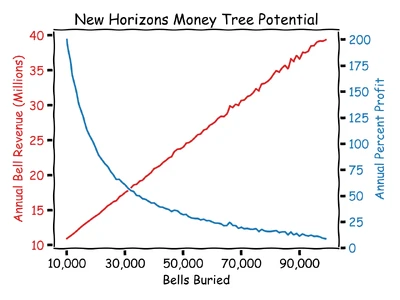
Simulated annual revenue and profit percent for amounts between 10,000 and 99,000 bells, each point averaged over 50 years. Planting more bells will yield greater revenue, but a lower overall profit.
If the player plants 99,000 bells in every glowing spot every day for a year, they will have planted a total of 36,135,000 bells. Statistically, with 30% of the trees being 297,000 bells, and 70% being 30,000 bells, you can theoretically expect to harvest 40,186,500 bells from money trees for a profit of 4,051,500 bells; an 11.21% profit with an average daily profit of 11,100 bells.
If the player plants 10,000 bells in every glowing spot every day they will have planted 3,650,000 bells. They then will have a 100% chance of getting 3x 10,000 bells every tree for a guaranteed harvest of 10,950,000 bells. This is a profit of 7,300,000 bells; a 200% profit with a guaranteed daily profit of 20,000 bells.
Some sources tell players to plant 30,000 bells daily. This ensures that they have zero loss when they only harvest 30,000 bells back from the tree. However, the expected profit from planting 30,000 bells is an 18,000 bell profit per tree. Planting 10,000 bells is always a 20,000 bell profit.
The player should always plant 10,000 bells, for not only a better profit but a more guaranteed one.
Money Tree Probability (Pre-New Horizons)
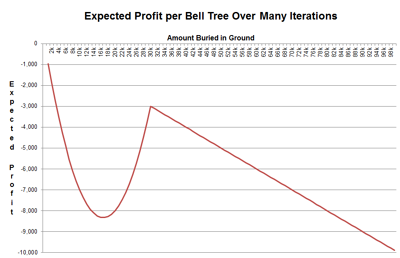
Because of the 90,000 Bell cap, planting money trees is not long-term profitable no matter how many Bells the player invests into the ground.
The likelihood of a tree blooming is dependent on the amount of Bells buried. The maximum amount of Bells any tree may produce is 90,000, and it will bloom only once, meaning that it is detrimental to bury an amount exceeding 90,000 Bells. Unfortunately, money trees are not statistically profitable. It is more akin to gambling at a casino—if someone plays long enough, they are more likely to lose. This is because despite the money tree's chance to bloom, which varies upon how many Bells are initially buried, the expected return will never exceed the amount invested. If two or more money trees are planted during the same day, only one will bloom, so it is wise to plant money trees on different days.
| Bells buried | Bloom chance | Bells dropped | Expected return | % return |
|---|---|---|---|---|
| 1,000 | 1% | 3,000 | 30 | 3% |
| 5,000 | 5% | 15,000 | 750 | 15% |
| 10,000 | 10% | 30,000 | 3,000 | 30% |
| 20,000 | 20% | 60,000 | 12,000 | 60% |
| 30,000 | 30% | 90,000 | 27,000 | 90% |
| 40,000 | 40% | 90,000 | 36,000 | 90% |
| 50,000 | 50% | 90,000 | 45,000 | 90% |
| 60,000 | 60% | 90,000 | 54,000 | 90% |
| 70,000 | 70% | 90,000 | 63,000 | 90% |
| 80,000 | 80% | 90,000 | 72,000 | 90% |
| 90,000 | 90% | 90,000 | 81,000 | 90% |
| 100,000 | 100% | 90,000 | 90,000 | 90% |
| 110,000 | 100% | 90,000 | 90,000 | 82% |
| 120,000 | 100% | 90,000 | 90,000 | 75% |
Given this data, the most advantageous amount to bury would be 30,000 Bells, giving a 30% probability of tripling the player's profits. This is because:
- To minimize the expected loss, it is best to bury an amount between [30,000 to 100,000] because the expected return is 90% of the initial investment. Less, and the reward drops with the probability resulting in a lower expectation; more, and the player is removing the random probability from it (100% chance) and sealing their fate at a return of 90,000 Bells.
- To maximize potential gain, it is best to bury an amount between [1,000 to 30,000] because if the player's gamble is successful, their reward will be triple their investment.
Dealing with Deforestation
The ability to grow trees from money is tremendously useful in dealing with excessive deforestation, possibly caused by the player due to inconvenient tree placement. With 10,000 Bells, over 10 trees can be planted in one day. Although slightly more expensive than purchasing saplings from Leif or Tom Nook's store, it is much quicker.
Gallery
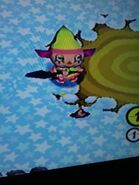
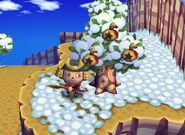
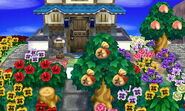
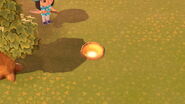
An empty golden spot for bells to be buried in New Horizons.
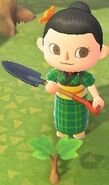

Nursery sapling tree inside a player's inventory in New Horizons.
Trivia
- These trees may be based on the expression "money doesn't grow on trees".
References
| Plants | ||
|---|---|---|
| Bamboo • Bush • Clover • Dandelion • Flower • Flower Fest • Fruit • Grass • Grass Deterioration • Jacob's Ladder • Money Tree • Mushroom • Palm • Rafflesia • Stump • Tree • Weed | ||
How To Make Money Trees In Animal Crossing
Source: https://animalcrossing.fandom.com/wiki/Money_tree#:~:text=To%20grow%20them%2C%20the%20player,becoming%20a%20regular%20hardwood%20tree.
Posted by: wilsoneigerstand.blogspot.com

0 Response to "How To Make Money Trees In Animal Crossing"
Post a Comment